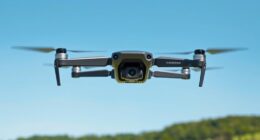Transit hubs are now prioritizing visual and tactile alerts to make airports and stations more deaf-inclusive. Digital signs, high-contrast signage, symbols, and color coding deliver real-time updates and important safety information. These improvements help you navigate easily and stay informed, regardless of hearing ability. Although implementing these solutions can be challenging, successful examples show they greatly improve passenger safety and experience. Keep exploring to discover how these innovations can benefit everyone and what’s next in accessible transit.
Key Takeaways
- Transit authorities are adopting visual signage and digital displays with sign language to improve communication for deaf and hard-of-hearing travelers.
- Color-coded signs and pictograms enhance quick understanding of alerts, directions, and safety information in transit hubs.
- Digital signage with real-time updates and captioning provides accessible, immediate information tailored to diverse passenger needs.
- Implementation challenges like costs are addressed through scalable technology, staff training, and strategic signage placement for maximum visibility.
- Successful case studies demonstrate the use of universal symbols, tactile signage, and inclusive communication to foster safer, more accessible transit environments.
The Shift Toward Visual Communication in Transit Hubs
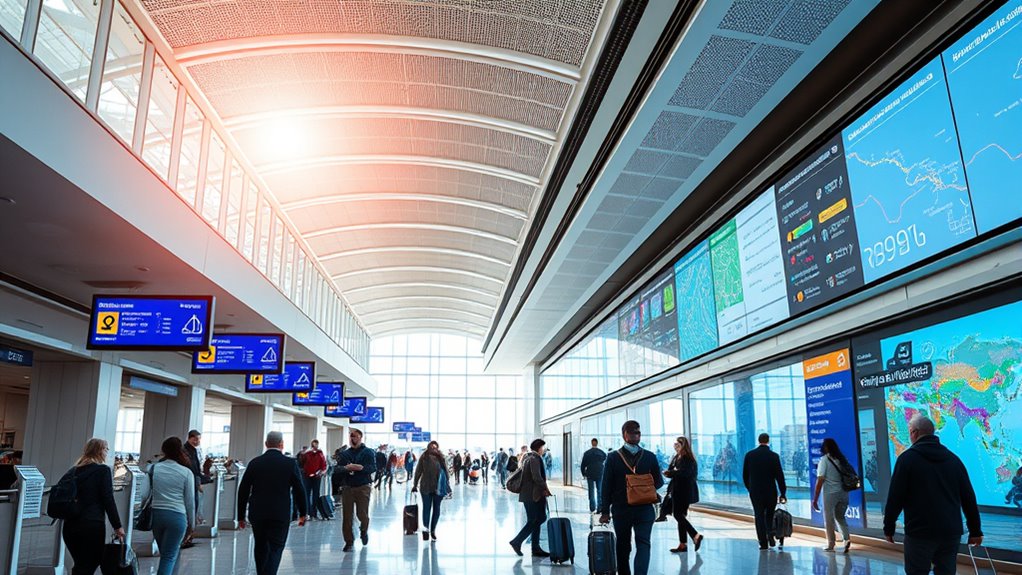
As transit authorities recognize the importance of inclusivity, many are shifting toward visual communication in transit hubs. You’ll notice this change through sign language integration on digital displays and announcements, making information accessible to deaf travelers. Tactile signage also plays an essential role, allowing visually impaired individuals to navigate stations confidently. These measures guarantee everyone can access real-time updates, safety instructions, and directions without relying solely on auditory cues. By implementing visual alerts and tactile signage, transit systems are proactively removing barriers, creating a more equitable environment. This shift not only benefits those with sensory impairments but also enhances overall accessibility, making your transit experience smoother and more inclusive. Additionally, visual communication is increasingly recognized as a vital component in creating accessible public spaces, reflecting a broader commitment to universal design principles. Incorporating safety features such as visual alarms and alerts further ensures that all passengers can be informed promptly in emergency situations. Emphasizing the importance of accessible technology helps ensure that innovations serve all users effectively. Moreover, integrating inclusive design strategies fosters a welcoming environment for diverse passengers, promoting equality and respect across transit systems.
Types of Visual Alerts Used in Airports and Stations

To guarantee everyone can navigate airports and stations effectively, transit systems employ a variety of visual alerts tailored to different needs. Signage customization plays a vital role, allowing displays to be tailored for clarity and visibility. You’ll notice color coding used extensively, such as green for departures, red for emergencies, and blue for information, helping you quickly interpret alerts at a glance. Bright, high-contrast signs ensure visibility in busy environments, and symbols complement text for universal understanding. Digital screens display real-time updates, while static signs provide essential directions. By combining signage customization with strategic color coding, transit authorities create an accessible environment that supports deaf and hard-of-hearing travelers, guaranteeing everyone receives critical alerts efficiently without relying solely on auditory cues. Additionally, incorporating visual communication methods enhances overall accessibility for all passengers. Moreover, understanding credit card terms can be helpful if you need to make quick purchases or access services during your travels. Implementing assistive technology can further improve communication for travelers with various disabilities.
Advantages of Digital Signage for Deaf and Hard-of-Hearing Travelers
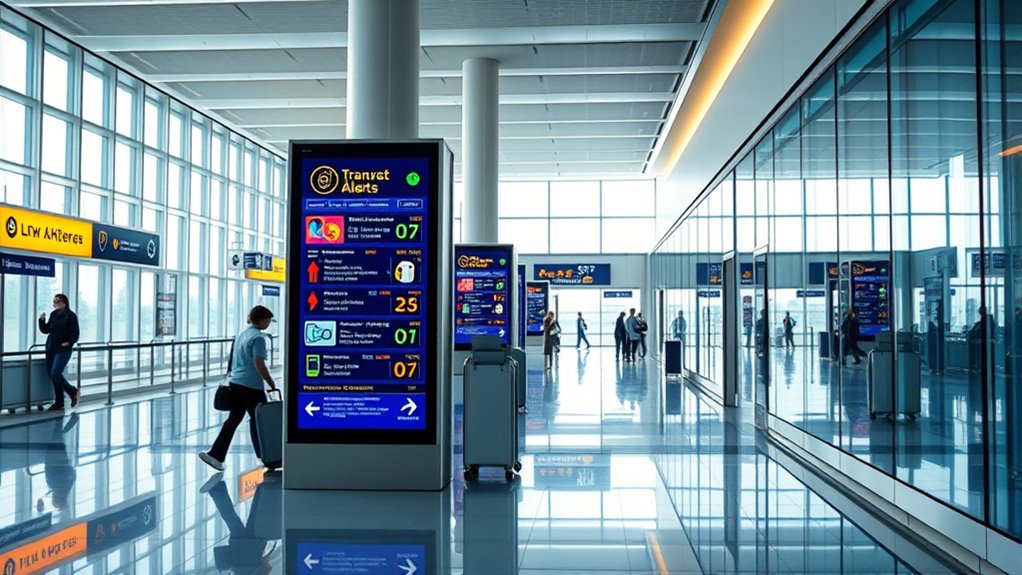
Digital signage offers significant advantages for deaf and hard-of-hearing travelers by providing clear, immediate, and accessible information. With features like captioning technology, you receive real-time updates on delays, gate changes, and safety instructions. Sign language integration enhances understanding, making communication more inclusive. These systems ensure you don’t miss critical information, reducing confusion and stress during your journey. By combining visual cues with text, digital signage creates a seamless experience tailored to your needs. Furthermore, the flexibility of digital displays allows for quick updates, ensuring information remains current. The integration of visual communication technologies enhances overall accessibility, transforming transit environments into accessible spaces, empowering you to navigate confidently. Incorporating macronutrient tracking features can also help travelers maintain their health while on the go. Additionally, implementing user-centric design principles ensures that these systems meet diverse needs effectively, and leveraging vetted materials guarantees durability and long-term performance of the signage.
Implementation Challenges and Solutions
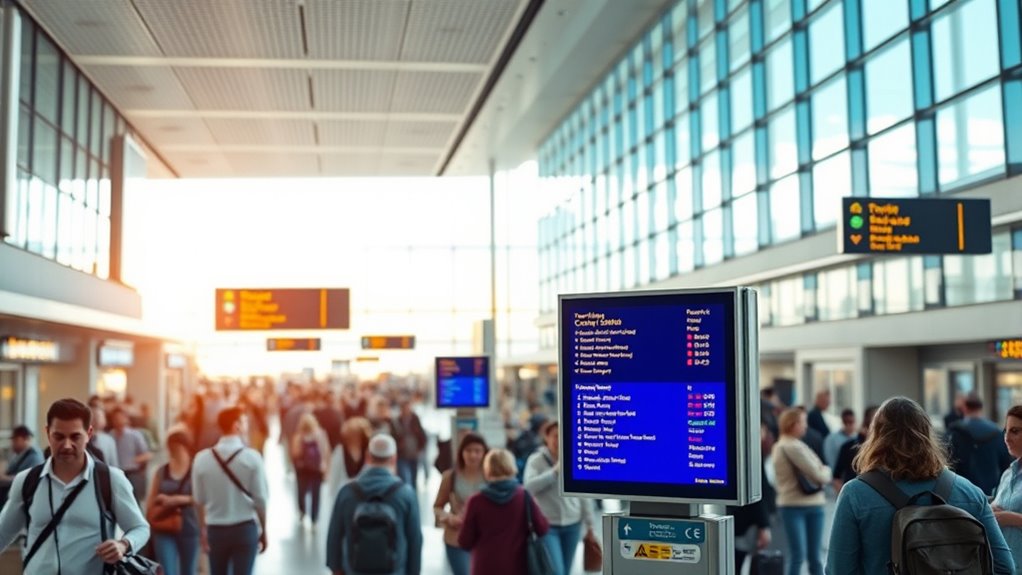
Implementing deaf-inclusive digital signage in transit systems presents several challenges, including high installation costs and technical complexities. Accessibility barriers can hinder seamless integration, requiring careful planning. Additionally, staff training is essential to guarantee effective use and maintenance. To overcome these issues, consider:
Implementing deaf-inclusive signage requires careful planning, training, and strategic investment.
- Investing in scalable technology that minimizes upfront costs while allowing future upgrades.
- Developing thorough staff training programs focused on accessibility features and troubleshooting.
- Partnering with experts to address technical complexities and ensure signage meets deaf and hard-of-hearing needs.
- Regular maintenance and updates are crucial to sustain the performance and reliability of the system, especially given the importance of support hours technology for energy efficiency and climate adaptability. Incorporating user-centered design principles can further improve overall accessibility and user experience.
- Incorporating security system features can further enhance safety and accessibility, ensuring the signage remains functional and reliable under various conditions.
- Ensuring compatibility with assistive communication tools can improve overall accessibility and user experience for deaf and hard-of-hearing users.
Case Studies of Successful Deaf-Inclusive Transit Systems
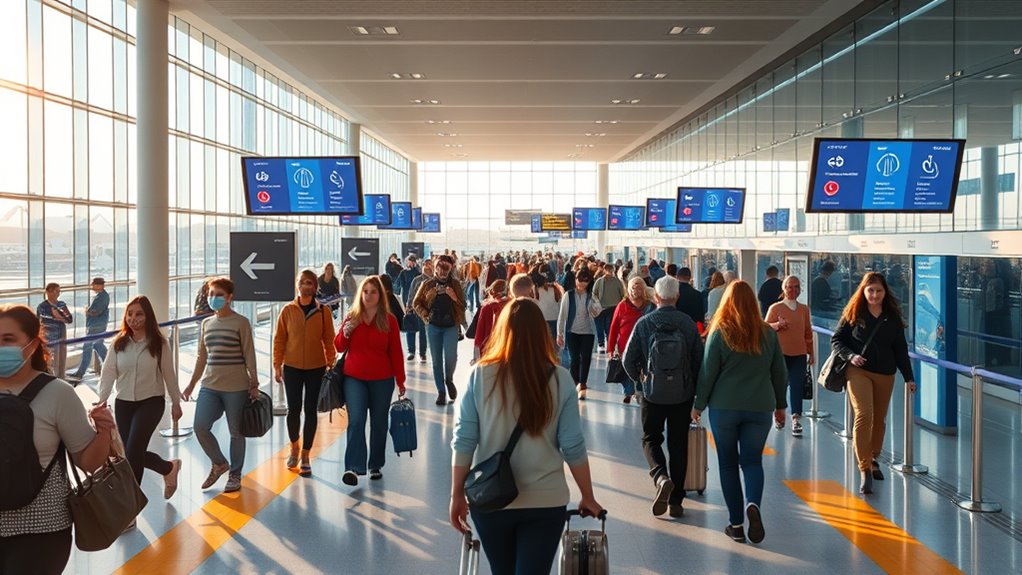
You’ll see how transit systems have successfully used visual signage to alert deaf riders quickly and clearly. Inclusive communication strategies, like real-time text updates and visual alerts, make transit more accessible for everyone. These case studies highlight practical ways to implement deaf-friendly features that improve daily travel experiences.
Visual Signage Implementation
Successful deaf-inclusive transit systems have prioritized visual signage to guarantee clear communication for all users. Effective signage design combines clarity, visibility, and intuitive layout. Here are three key elements:
- Clear symbols and icons: Use universally recognized visuals to convey messages quickly.
- Consistent color coding: Implement distinct colors for different alerts, such as red for emergencies or green for directions, enhancing quick recognition.
- Strategic placement: Position signs at eye level and in high-traffic areas to maximize visibility and accessibility.
Inclusive Communication Strategies
Building on the foundation of visual signage, inclusive communication strategies guarantee that deaf and hard-of-hearing users receive timely and effective information. Well-designed signage plays a vital role in conveying alerts clearly and quickly, reducing confusion during emergencies or routine updates. Additionally, positive customer reviews highlight the importance of durable and reliable signage that can withstand daily wear and tear, ensuring consistent communication. Moreover, visual communication techniques like symbols and pictograms enhance understanding for diverse users, making information accessible beyond language barriers. Equally important is staff training, which ensures personnel understand how to assist deaf travelers effectively, using methods like sign language or written communication. Successful transit systems incorporate these elements by designing signage that’s intuitive and easy to understand while equipping staff to provide consistent support. These strategies foster a more inclusive environment, making transit accessible and safe for everyone. Implementing thorough signage design and ongoing staff training demonstrates a commitment to deaf inclusion, setting a standard others can follow. Additionally, effective signage, based on clear visual principles, enhances overall communication and minimizes misinterpretation during critical moments, especially when considering accessible design that takes into account diverse user needs. Incorporating mindfulness and emotional intelligence into staff interactions can further improve communication quality and foster a welcoming atmosphere for all users.
Impact on Overall Passenger Experience and Safety
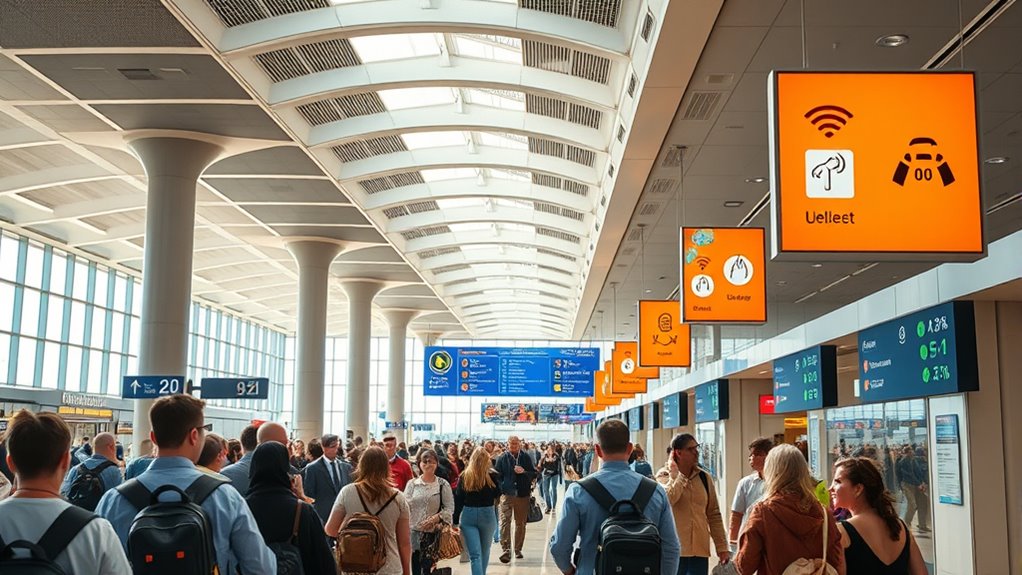
By making transit alerts deaf-inclusive, transportation systems substantially enhance the overall passenger experience and safety. You benefit from clearer communication through sign language integration, which ensures you understand alerts quickly. Additionally, tactile signage provides crucial information for those with visual impairments, making guidance safer and more intuitive. Here’s how these improvements impact you:
- Faster response times during emergencies or delays, thanks to clear visual and tactile cues.
- Increased confidence when steering through busy stations, as information is accessible and easy to interpret.
- A more inclusive environment that respects diverse communication needs, reducing anxiety and stress.
- Developing attention to detail in implementing these features helps maintain high safety standards and ensures that all passengers feel accommodated. Incorporating accessible design principles further enhances usability for everyone. Recognizing the importance of mindfulness during the implementation process can help ensure that the needs of diverse users are thoughtfully addressed. An awareness of universal design can inform the creation of transit environments that are welcoming for all. Incorporating coastal zone awareness — understanding the importance of wave and wind conditions — can inform the design of outdoor transit environments to improve safety and comfort.
These features not only improve safety but also foster a sense of belonging for deaf and hard-of-hearing passengers, making transit more reliable and welcoming for everyone.
Future Innovations in Deaf-Friendly Transit Technologies
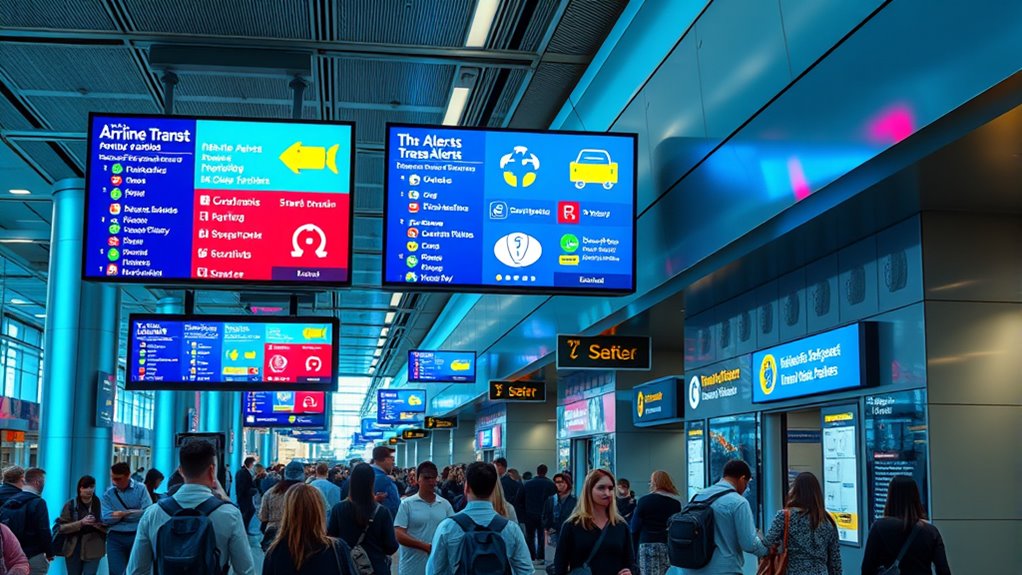
Imagine new ways to stay informed during your commute, like real-time visual alerts that catch your eye instantly. Wearable deaf-assist devices could provide personalized notifications directly to you, enhancing safety and independence. These innovations promise to make transit more inclusive and accessible for everyone.
Real-Time Visual Alerts
Real-time visual alerts are transforming how deaf passengers stay informed about transit updates. These alerts use clear visual language to communicate important information instantly. Effective signage design ensures messages are easily understood at a glance. Here are three ways these innovations enhance your experience:
- Dynamic displays with bright, high-contrast visuals catch your attention quickly.
- Customizable signage that adjusts for different languages or symbols simplifies understanding.
- Integration with station maps provides real-time updates on delays, arrivals, or emergencies.
These advancements make transit more accessible and reduce reliance on audio announcements. By prioritizing visual language and thoughtful signage design, transit authorities create a seamless experience, keeping everyone informed and safe. Real-time visual alerts are a crucial step toward truly inclusive transportation.
Wearable Deaf-Assist Devices
Building on visual alerts, wearable deaf-assist devices are poised to revolutionize how you navigate transit systems. These devices use sensors that detect visual cues and translate them into vibrations or signals that you can feel, reducing your reliance on screens or static signs. Some models incorporate sign language recognition, enabling real-time interpretation of spoken announcements or alerts, which makes communication faster and more natural. Wearables can also sync with transit apps to alert you about delays, arrivals, or emergencies through gentle taps or vibrations. This technology empowers you to stay connected and informed without missing critical information, enhancing independence and safety. As these devices become more advanced, they’ll seamlessly integrate with existing systems, making your transit experience more inclusive and accessible.
How to Support Inclusive Communication in Public Transportation
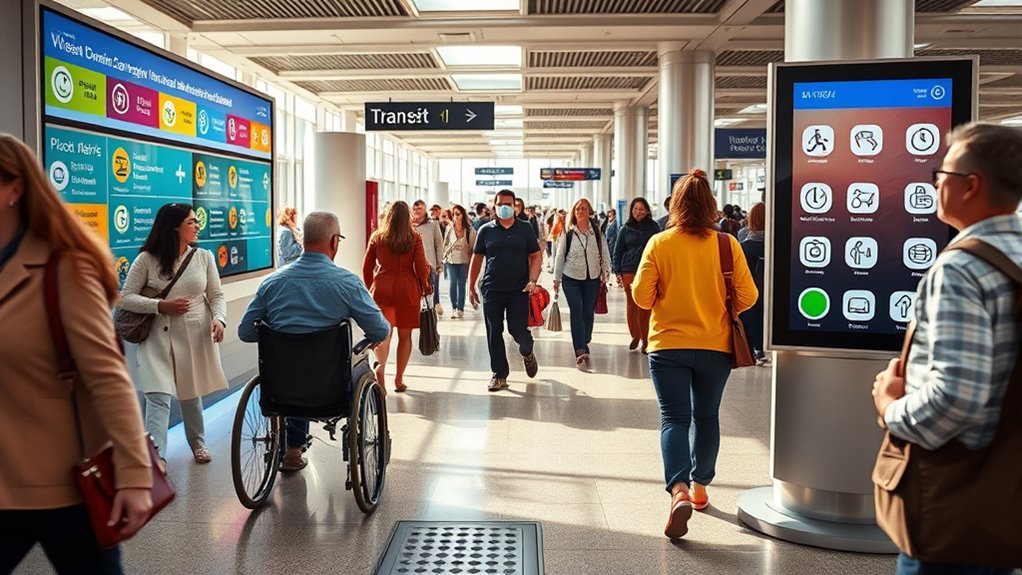
To support inclusive communication in public transportation, establishing clear and accessible methods that cater to all passengers, including those who are deaf or hard of hearing, is essential. Consider these key strategies:
- Provide sign language interpretation at key points like ticket counters and information desks to ensure deaf passengers can access assistance easily.
- Install tactile paving along pathways and near platforms to guide visually impaired and deaf passengers safely through stations.
- Use visual alerts, such as digital displays and flashing lights, to communicate important updates like delays or arrivals.
These measures help create a more inclusive environment, guaranteeing everyone can navigate public transportation confidently and independently. Supporting diverse communication needs benefits all passengers and promotes equitable access.
Frequently Asked Questions
How Do Visual Alerts Compare to Auditory Announcements in Effectiveness?
You may find visual alerts more effective than auditory announcements because they improve signage clarity and alert visibility, especially in noisy environments. Visual cues ensure everyone, including those with hearing impairments, can quickly understand important information. While auditory alerts can be missed or misunderstood, well-designed visual alerts provide consistent, immediate communication. Combining both methods offers the best coverage, but visual alerts are especially vital for accessibility and clarity.
Are There Specific Standards or Regulations Guiding Deaf-Inclusive Transit Signage?
You might think there are strict signage standards and accessibility regulations guiding deaf-inclusive transit signage, and you’re right. These standards, like the ADA in the U.S., require clear visual cues—such as symbols and text—to guarantee accessibility for all. Regulations emphasize consistent, easy-to-understand signage that enhances independence and safety for deaf individuals. By following these guidelines, transit systems create a more inclusive environment, making information accessible beyond auditory announcements.
What Training Do Staff Receive to Assist Deaf and Hard-Of-Hearing Travelers?
You’ll find that staff receive specialized sign language training to effectively communicate with deaf and hard-of-hearing travelers. Additionally, they participate in staff sensitivity workshops, which help build awareness and understanding of diverse communication needs. These trainings ensure you get respectful, clear assistance, making your transit experience smoother. The focus is on empowering staff to be more inclusive, so you feel welcomed and supported throughout your journey.
How Are Visual Alerts Customized for Different Languages or Regions?
You’ll find that visual alerts are customized using multilingual signage and regional iconography, making them accessible for diverse populations. By incorporating multiple languages, you guarantee travelers understand critical information regardless of their language background. Regional iconography helps convey messages universally, even if language barriers exist. These tailored visual alerts improve navigation and safety, creating a more inclusive environment for everyone, especially in multicultural or international settings.
What Funding Options Support the Implementation of Deaf-Friendly Transit Technologies?
You might find it surprising, but funding sources like government budgets and technological grants play a key role in supporting deaf-friendly transit tech. These grants often aim to make transportation more accessible for everyone. By applying for such grants, you can fund the integration of visual alerts and other deaf-inclusive features, ensuring your transit system becomes more inclusive and user-friendly. These financial options help turn accessible ideas into reality.
Conclusion
By embracing visual alerts, you’re opening the doors to a more inclusive transit world, turning stations into vibrant beacons of safety and accessibility. Just like a lighthouse guides ships through darkness, these innovations illuminate the path for deaf and hard-of-hearing travelers. Your support and understanding can help transform busy hubs into welcoming spaces where everyone feels seen, heard, and safe—guiding all of us toward a future where no one is left in the shadows.











